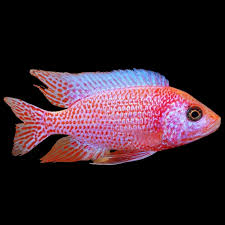1
/
of
1
Midwest Aquarium and Pond Supplier LLC
(108) Pink Dragon Blood Peacock Cichlid 3in
(108) Pink Dragon Blood Peacock Cichlid 3in
Regular price
$100.00 USD
Regular price
Sale price
$100.00 USD
Shipping calculated at checkout.
Quantity
Couldn't load pickup availability
The Pink Dragon Blood Peacock Cichlid (Aulonocara sp. hybrid) is a selectively bred, hybrid African cichlid known for its vibrant pink and orange coloration. It is not a wild species and is primarily found in the aquarium trade. The care for this fish is similar to that of other Peacock cichlids from Lake Malawi.
Tank and water requirements
- Tank size: A minimum of a 55-gallon tank is recommended for a small group, with 75 gallons or more being ideal, especially if housing multiple males.
- Substrate: Use a fine, sand-like substrate, as these cichlids are bottom-sifters. Coarse gravel can injure their gills.
- Filtration: A robust filtration system is essential to handle their bioload and maintain clean water conditions.
-
Water parameters:
- Temperature: Maintain a stable temperature between 76–82°F.
- pH: A high pH of 7.8–8.6 is necessary to replicate their native Lake Malawi habitat.
- Decorations: Provide plenty of stacked rocks, caves, and crevices to create territories and hiding places. Ensure there is also ample open swimming space.
Diet and feeding
- Omnivorous diet: Pink Dragon Blood Peacocks are omnivores that benefit from a varied diet.
- Food types: A combination of high-quality cichlid pellets or flakes, supplemented with live or frozen foods like brine shrimp and bloodworms, is recommended.
- Feeding schedule: Feed small amounts once or twice daily, ensuring all food is consumed within a few minutes.
Temperament and tank mates
- Semi-aggressive: They are generally more peaceful than mbuna cichlids but can display territorial behavior, especially toward other males.
- Social dynamics: To minimize aggression, keep a male-to-female ratio of at least 1:3.
- Tank mates: They are best kept with other similarly sized and tempered Peacock cichlids (Aulonocara species) and Haps (Haplochromine cichlids). Avoid smaller, more passive fish.
Breeding
- Maternal mouthbrooders: Like other peacocks, the female carries the fertilized eggs and fry in her mouth for protection, usually for about three weeks.
- Spawning behavior: Males will court a female and dig a small pit in the sand for spawning.
Share
No reviews

